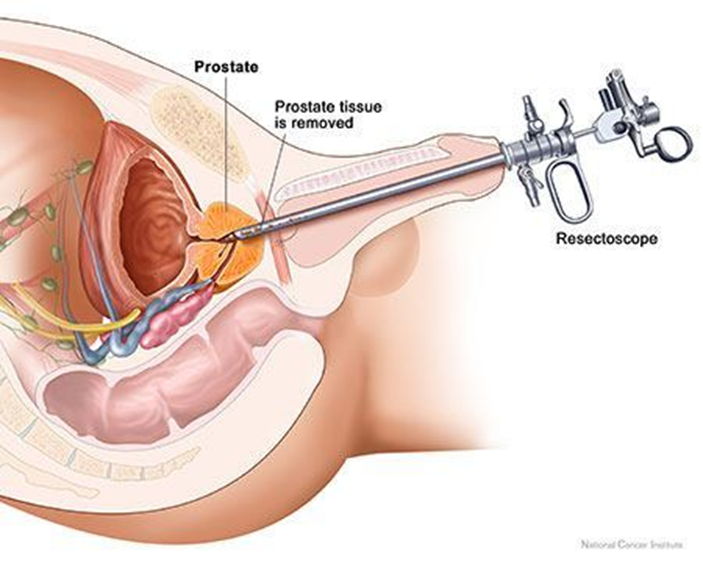A client arrives to the medical-surgical unit 4 hours after a transurethral resection of the prostate. A triple-lumen catheter for continuous bladder irrigation with normal saline is infusing and the nurse observes dark, pink-tinged outflow with blood clots in the tubing and collection bag. Which action should the nurse take?
Irrigating the catheter manually.
Monitoring catheter drainage.
Discontinuing infusing solution.
Decreasing the flow rate.
The Correct Answer is B
A. Irrigating the catheter manually:
Manually irrigating the catheter without an order may disrupt the clotting process and increase the risk of bleeding. It is not a routine nursing intervention post-TURP without specific orders.
B. Monitoring catheter drainage.
It is not within the nurse's scope of practice to manually irrigate the catheter without a healthcare provider's order, especially in the context of post-TURP care. The dark, pink-tinged outflow with blood clots indicates some expected bleeding following the procedure. The nurse should closely monitor the catheter drainage for the amount, color, and presence of clots.
C. Discontinuing infusing solution:
Discontinuing the normal saline irrigation may lead to clot formation and obstruction, potentially worsening the situation. The continuous bladder irrigation is often used to prevent clot formation and maintain catheter patency post-TURP.
D. Decreasing the flow rate:
The flow rate is typically set by the healthcare provider to maintain catheter patency and prevent clot formation. Decreasing the flow rate without specific orders may not be appropriate in this situation.

Nursing Test Bank
Naxlex Comprehensive Predictor Exams
Related Questions
Correct Answer is D
Explanation
A. Measure the client's blood pressure:
While monitoring blood pressure is an important aspect of assessing a client's overall condition, it is not the immediate priority in a suspected opioid overdose. Respiratory depression and difficulty in arousing are more critical concerns that warrant prompt intervention with naloxone.
B. Remove all of the morphine patches:
While eventually, the nurse will need to address the presence of multiple morphine patches, removing them is not the first action. Administering naloxone to reverse the opioid effects takes precedence over patch removal.
C. Apply oxygen per face mask:
While providing oxygen may be necessary to support respiratory function, it doesn't address the underlying cause of the respiratory distress, which is likely opioid toxicity. Administering naloxone is the more direct and immediate intervention to counteract the effects of the opioids.
D. Administer a narcotic antagonist:
This is the correct and immediate priority. If the client is difficult to arouse and has multiple morphine patches, it raises concerns about opioid toxicity. Naloxone is a narcotic antagonist that can reverse the effects of opioid overdose, particularly respiratory depression, and is crucial in this scenario to restore normal respiratory function.
Correct Answer is C
Explanation
A. Hyperactive bowel sounds.
Hyperactive bowel sounds are more suggestive of gastrointestinal issues, such as intestinal hypermotility or increased peristalsis. While diabetes can affect the gastrointestinal system, hyperactive bowel sounds are not a specific indicator of the symptoms described by the client.
B. Anxiety and sighing.
Anxiety and sighing are more indicative of emotional or psychological factors rather than dehydration. While stress can impact blood sugar levels in individuals with diabetes, anxiety and sighing are not direct signs of the dehydration that may be associated with the reported symptoms.
C. Dark yellow urine.
Dark yellow urine can be a sign of concentrated urine, suggesting dehydration. In diabetes, especially when blood sugar levels are elevated, increased urine production (polyuria) can lead to dehydration. Dark yellow urine may indicate that the urine is more concentrated due to a lack of fluid intake.
D. Myalgia in wrists and hands.
Myalgia in the wrists and hands is not a typical symptom of dehydration related to diabetes. It could be associated with various conditions, such as musculoskeletal issues or nerve-related problems. This symptom is less likely to be directly linked to the reported weakness and palpitations.
Whether you are a student looking to ace your exams or a practicing nurse seeking to enhance your expertise , our nursing education contents will empower you with the confidence and competence to make a difference in the lives of patients and become a respected leader in the healthcare field.
Visit Naxlex, invest in your future and unlock endless possibilities with our unparalleled nursing education contents today
Report Wrong Answer on the Current Question
Do you disagree with the answer? If yes, what is your expected answer? Explain.
Kindly be descriptive with the issue you are facing.
